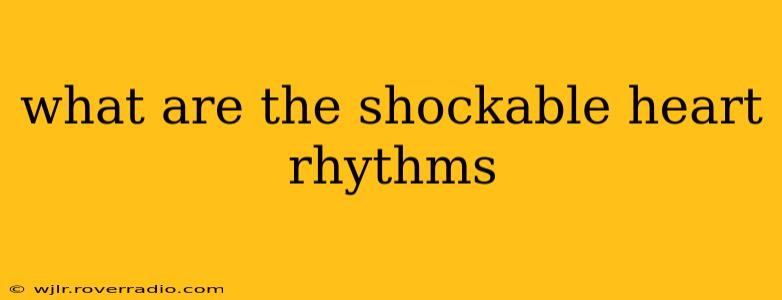Understanding shockable heart rhythms is crucial in emergency situations involving cardiac arrest. Defibrillation, the process of delivering an electric shock to the heart, is a life-saving intervention, but it's only effective for specific, life-threatening arrhythmias. Improper use can be dangerous, so precise identification of these rhythms is paramount.
This guide will delve into the key shockable rhythms, explaining what they are, why they are dangerous, and how they are identified. We'll also address some common questions surrounding this vital topic.
What is Defibrillation and Why is it Used?
Defibrillation aims to terminate chaotic electrical activity in the heart that prevents it from pumping blood effectively. This chaotic activity manifests as abnormal heart rhythms, or arrhythmias. The electric shock depolarizes a large mass of cardiac muscle cells simultaneously, allowing the heart's natural pacemaker (the sinoatrial node) to resume its normal rhythm.
Without prompt defibrillation in cases of shockable rhythms, the brain and other organs will quickly be deprived of oxygenated blood, leading to irreversible damage and death.
What are the Main Shockable Rhythms?
The two primary shockable heart rhythms are:
1. Ventricular Fibrillation (VF): This is a chaotic, disorganized quivering of the ventricles. The heart is not pumping blood at all, resulting in cardiac arrest. On an electrocardiogram (ECG), VF appears as a disorganized baseline with no discernible P waves, QRS complexes, or T waves. It's a life-threatening emergency requiring immediate defibrillation.
2. Pulseless Ventricular Tachycardia (pVT): This is a rapid heart rhythm originating in the ventricles. While there's electrical activity, the heart's chambers are contracting so fast and inefficiently that they are unable to pump blood effectively, leading to a lack of pulse and cardiac arrest. On an ECG, pVT shows a rapid series of wide QRS complexes without discernible P waves, indicating ventricular origin. Immediate defibrillation is crucial.
What Rhythms are NOT Shockable?
It's equally important to understand which rhythms are not appropriate for defibrillation. Shocking these rhythms can be harmful and ineffective:
-
Asystole (Flatline): This represents the complete absence of electrical activity in the heart. Defibrillation won't work because there's no electrical activity to interrupt. CPR and medications are the appropriate interventions.
-
Pulseless Electrical Activity (PEA): In PEA, there is organized electrical activity on the ECG, but the heart isn't pumping blood effectively. The electrical signals aren't strong enough to cause effective contractions. CPR and medications are necessary to treat the underlying cause.
How are Shockable Rhythms Diagnosed?
Shockable rhythms are primarily diagnosed using an electrocardiogram (ECG). Trained medical professionals, such as paramedics and emergency room physicians, interpret the ECG tracing to identify the heart rhythm and determine the appropriate treatment. Automated External Defibrillators (AEDs) also analyze the heart rhythm and advise whether a shock is needed.
What are the Chances of Survival with Defibrillation?
The chances of survival after cardiac arrest significantly increase with early defibrillation. Every minute without defibrillation reduces the likelihood of successful resuscitation. Immediate CPR followed by defibrillation offers the best chance of survival. Survival rates vary depending on factors like the cause of the arrest, the time to defibrillation, and the quality of post-resuscitation care.
Is it possible to mistakenly shock a non-shockable rhythm?
Yes, it is possible, though thankfully modern AEDs have significantly reduced this risk with their rhythm analysis capabilities. However, misinterpretations can still occur. This underscores the critical importance of proper training and adherence to established protocols for the use of defibrillators. Misuse of defibrillation can be dangerous and potentially life-threatening.
This information is for educational purposes only and should not be considered medical advice. Always consult with a healthcare professional for any health concerns.
